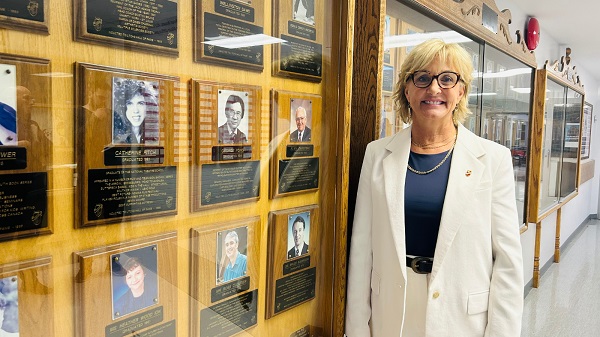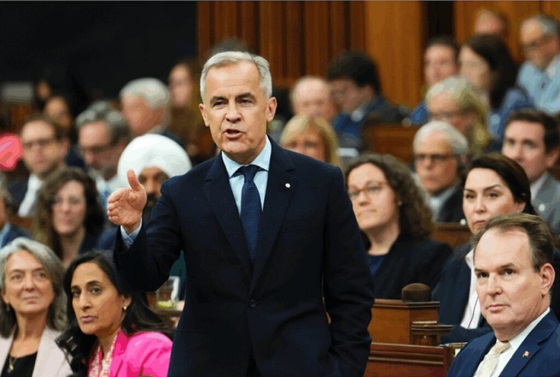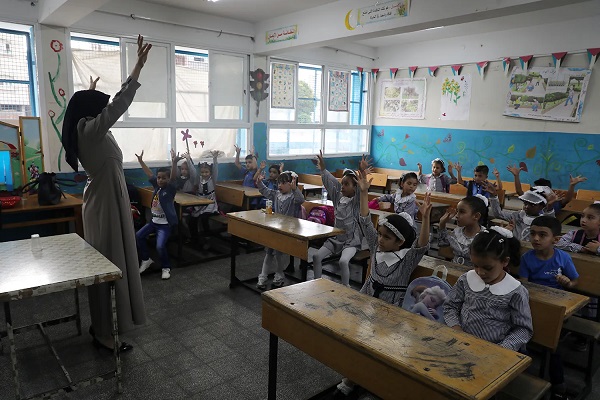Education
Val Jenson joins the LTCHS Hall of Fame

Local community builder inducted into LTCHS Hall of Fame
A dynamic Red Deerian who has touched the lives of many across the community over the years has been inducted into the Lindsay Thurber Comprehensive High School Hall of Fame.
As part of the Class of 1976, Val Jensen made her mark at the school as an influential student leader, serving on the Student Council and also as the Graduation President during her graduating year.
An induction ceremony and luncheon was held on Oct. 15 to celebrate Val’s significant contributions not only to the school, but to the community as well. The Lindsay Thurber Comprehensive High School Hall of Fame recognizes alumni who have made a difference in their community, while being role models for future graduates.
“Being inducted into the Lindsay Thurber Hall of Fame is truly an honour,” said Val. “This community has always been close to my heart, and to be recognized among such inspiring individuals is incredibly humbling. It reminds me of the amazing people who have shaped this school and our community over the years.”
Val’s dedication to physical activity and wellness is evident in her impressive athletic achievements, including competing in Alpine Skiing at the Alberta Winter Games and representing Canada as a member of the duathlon and triathlon teams. Val has also completed numerous marathons and Ironman races worldwide, including the prestigious Ironman Hawaii.
In 1987 Val founded Dance Magic Studio, offering children of all ages and abilities, a chance to explore the joy of dance. Val has served as the Race Director for Woody’s Triathlon many times and was the chairperson for the Alberta Winter Games opening ceremonies in 2006. She also played a vital role during the Canada Winter Games 2019 bid as co-chair of the community engagement and was the founder of the PCN Fun Run, serving as its Race Director for a decade. Additionally, she coordinates the Aloha School Run, which sees participation from 10,000 students across Central Alberta each year. Her extensive volunteer work has empowered countless Red Deerians to train and compete in a way that connects people through activity.
“Physical activity and healthy living have always been a cornerstone of my life and my work in the community,” said Val. “I believe that staying active not only strengthens the body, but also builds resilience, confidence, and connection with others. It’s about creating habits that empower people to live their best lives.”
Val’s unwavering commitment to community service and her tireless work ethic have garnered well-deserved recognition. In 2012, the Red Deer & District Community Foundation honoured her as a Woman of Excellence, and in 2014 she received the Volunteer of the Year Award from the City of Red Deer Sport Council. Val’s contributions have also been recognized with the Golden Dove Award from the Mustard Seed in 2012, the Mayor’s Special Award in 2022, and the prestigious Queen Elizabeth II – Platinum Jubilee Medal in 2022.
Principal of Lindsay Thurber, Chris Good, said it’s always exciting to see where the future takes the school’s students after they graduate.
“At Lindsay Thurber, our school staff works hard to foster a love of learning and a desire to reach and attain your goals,” he said. “Val has remained an integral part of our community, and has gotten behind many different causes and organizations – all for the better of Red Deer. Val’s passion for wellness and her dedication to fostering community spirit continue to inspire us all, and we were thrilled to honour her.”
Alberta
Schools should go back to basics to mitigate effects of AI

From the Fraser Institute
Odds are, you can’t tell whether this sentence was written by AI. Schools across Canada face the same problem. And happily, some are finding simple solutions.
Manitoba’s Division Scolaire Franco-Manitobaine recently issued new guidelines for teachers, to only assign optional homework and reading in grades Kindergarten to six, and limit homework in grades seven to 12. The reason? The proliferation of generative artificial intelligence (AI) chatbots such as ChatGPT make it very difficult for teachers, juggling a heavy workload, to discern genuine student work from AI-generated text. In fact, according to Division superintendent Alain Laberge, “Most of the [after-school assignment] submissions, we find, are coming from AI, to be quite honest.”
This problem isn’t limited to Manitoba, of course.
Two provincial doors down, in Alberta, new data analysis revealed that high school report card grades are rising while scores on provincewide assessments are not—particularly since 2022, the year ChatGPT was released. Report cards account for take-home work, while standardized tests are written in person, in the presence of teaching staff.
Specifically, from 2016 to 2019, the average standardized test score in Alberta across a range of subjects was 64 while the report card grade was 73.3—or 9.3 percentage points higher). From 2022 and 2024, the gap increased to 12.5 percentage points. (Data for 2020 and 2021 are unavailable due to COVID school closures.)
In lieu of take-home work, the Division Scolaire Franco-Manitobaine recommends nightly reading for students, which is a great idea. Having students read nightly doesn’t cost schools a dime but it’s strongly associated with improving academic outcomes.
According to a Programme for International Student Assessment (PISA) analysis of 174,000 student scores across 32 countries, the connection between daily reading and literacy was “moderately strong and meaningful,” and reading engagement affects reading achievement more than the socioeconomic status, gender or family structure of students.
All of this points to an undeniable shift in education—that is, teachers are losing a once-valuable tool (homework) and shifting more work back into the classroom. And while new technologies will continue to change the education landscape in heretofore unknown ways, one time-tested winning strategy is to go back to basics.
And some of “the basics” have slipped rapidly away. Some college students in elite universities arrive on campus never having read an entire book. Many university professors bemoan the newfound inability of students to write essays or deconstruct basic story components. Canada’s average PISA scores—a test of 15-year-olds in math, reading and science—have plummeted. In math, student test scores have dropped 35 points—the PISA equivalent of nearly two years of lost learning—in the last two decades. In reading, students have fallen about one year behind while science scores dropped moderately.
The decline in Canadian student achievement predates the widespread access of generative AI, but AI complicates the problem. Again, the solution needn’t be costly or complicated. There’s a reason why many tech CEOs famously send their children to screen-free schools. If technology is too tempting, in or outside of class, students should write with a pencil and paper. If ChatGPT is too hard to detect (and we know it is, because even AI often can’t accurately detect AI), in-class essays and assignments make sense.
And crucially, standardized tests provide the most reliable equitable measure of student progress, and if properly monitored, they’re AI-proof. Yet standardized testing is on the wane in Canada, thanks to long-standing attacks from teacher unions and other opponents, and despite broad support from parents. Now more than ever, parents and educators require reliable data to access the ability of students. Standardized testing varies widely among the provinces, but parents in every province should demand a strong standardized testing regime.
AI may be here to stay and it may play a large role in the future of education. But if schools deprive students of the ability to read books, structure clear sentences, correspond organically with other humans and complete their own work, they will do students no favours. The best way to ensure kids are “future ready”—to borrow a phrase oft-used to justify seesawing educational tech trends—is to school them in the basics.
Business
Why Does Canada “Lead” the World in Funding Racist Indoctrination?
-

 Daily Caller2 days ago
Daily Caller2 days agoParis Climate Deal Now Decade-Old Disaster
-

 Business2 days ago
Business2 days agoOttawa Pretends To Pivot But Keeps Spending Like Trudeau
-

 International1 day ago
International1 day agoBondi Beach Shows Why Self-Defense Is a Vital Right
-

 Energy2 days ago
Energy2 days agoLiberals Twisted Themselves Into Pretzels Over Their Own Pipeline MOU
-

 Crime1 day ago
Crime1 day agoBondi Beach Survivor Says Cops Prevented Her From Fighting Back Against Terrorists
-

 Censorship Industrial Complex1 day ago
Censorship Industrial Complex1 day agoHow Wikipedia Got Captured: Leftist Editors & Foreign Influence On Internet’s Biggest Source of Info
-

 Automotive1 day ago
Automotive1 day agoFord’s EV Fiasco Fallout Hits Hard
-

 Frontier Centre for Public Policy14 hours ago
Frontier Centre for Public Policy14 hours agoCanada Lets Child-Porn Offenders Off Easy While Targeting Bible Believers












